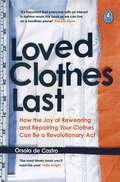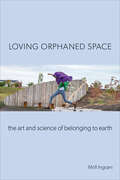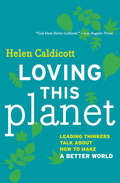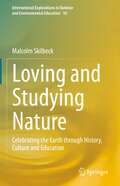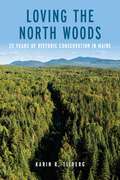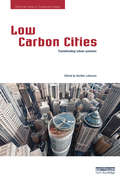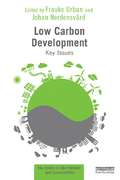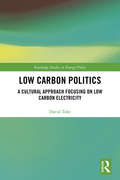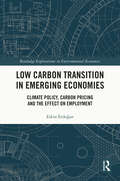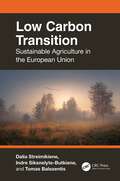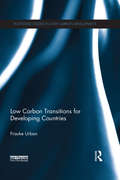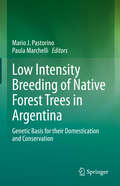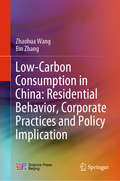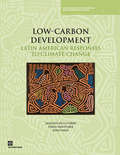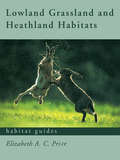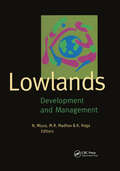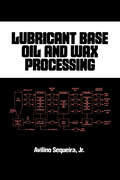- Table View
- List View
Loved Clothes Last: How the Joy of Rewearing and Repairing Your Clothes Can Be a Revolutionary Act
by Orsola de Castro'It's important that everyone with an interest in fashion reads this book so we can live on a healthier planet' Arizona Muse 'The most timely book you'll read this year' India Knight* * * * * Running out of space for the clothes you can't stop buying? Curious about how you can make a difference to the environmental challenges our planet faces? Join Orsola's care revolution and learn to make the clothes you love, last longer.This book will equip you with a myriad of ways to mend, rewear and breathe new life into your wardrobe to achieve a more sustainable lifestyle. By teaching you to scrutinise your shopping habits and make sustainable purchases, she will inspire you to buy better, care more and reduce your carbon footprint by simply making your loved clothes last longer.Following Orsola's practical tips to lavish care and attention on the clothes you already own will not only have a positive environmental impact, but will be personally rewarding too: hand wash, steam and spot clean your clothes, air dry instead of tumble drying, or revive your clothes by sewing or crocheting.Fast fashion leaves behind a trail of human and environmental exploitation. Our wardrobes don't have to be the finish line; they can be a starting point. We can all care, repair and rewear. Do you accept the challenge?* * * * *'An incredibly thoughtful, must-read guide' Kenya Hunt'A must read for anyone who wants to understand the fashion industry as an outsider and wants direction as to where we go next' Aja Barber
Loving Orphaned Space: The Art and Science of Belonging to Earth
by Mrill IngramHow we relate to orphaned space matters. Voids, marginalia, empty spaces—from abandoned gas stations to polluted waterways—are created and maintained by politics, and often go unquestioned. In Loving Orphaned Space, Mrill Ingram provides a call to action to claim and to cherish these neglected spaces and make them a source of inspiration through art and/or remuneration. Ingram advocates not only for “urban greening” and “green planning,” but also for “radical caring.” These efforts create awareness and understanding of ecological connectivity and environmental justice issues—from the expropriation of land from tribal nations, to how race and class issues contribute to creating orphaned space. Case studies feature artists, scientists, and community collaborations in Chicago, New York, and Fargo, ND, where grounded and practical work of a fundamentally feminist nature challenges us to build networks of connection and care. The work of environmental artists who venture into and transform these disconnected sites of infrastructure allow us to rethink how to manage the enormous amount of existing overlooked and abused space. Loving Orphaned Space provides new ways humans can negotiate being better citizens of Earth.
Loving Orphaned Space: The Art and Science of Belonging to Earth
by Mrill IngramHow we relate to orphaned space matters. Voids, marginalia, empty spaces—from abandoned gas stations to polluted waterways—are created and maintained by politics, and often go unquestioned. In Loving Orphaned Space, Mrill Ingram provides a call to action to claim and to cherish these neglected spaces and make them a source of inspiration through art and/or remuneration. Ingram advocates not only for “urban greening” and “green planning,” but also for “radical caring.” These efforts create awareness and understanding of ecological connectivity and environmental justice issues—from the expropriation of land from tribal nations, to how race and class issues contribute to creating orphaned space. Case studies feature artists, scientists, and community collaborations in Chicago, New York, and Fargo, ND, where grounded and practical work of a fundamentally feminist nature challenges us to build networks of connection and care. The work of environmental artists who venture into and transform these disconnected sites of infrastructure allow us to rethink how to manage the enormous amount of existing overlooked and abused space. Loving Orphaned Space provides new ways humans can negotiate being better citizens of Earth.
Loving This Planet: Leading Thinkers Talk About How to Make A Better World
by Helen CaldicottConversations on sustainability, renewable energy, and other pressing issues: &“A level of intellectual discussion all too absent in our national discourse.&” —Booklist A co-founder of Physicians for Social Responsibility, named one of the most influential women of the twentieth century by the Smithsonian Institute, Helen Caldicott presents a valuable collection of her interviews with prominent figures and environmentalists—in which she: *Scrutinizes our unsustainable dependence on nuclear energy *Explores how the United States could transition to renewable energy *Raises awareness about issues such as deforestation and sea-level rise Extending well beyond the scope of conventional environmental discussions, this book gives us Martin Sheen on grassroots movements and unionized labor; Chris Hedges on the costs of standing up for your morals; and award-winning actress Lily Tomlin on contemporary politics, in a sarcastic and witty exchange at once hilarious and inspiring—and also includes interviews with Maude Barlow, Bill McKibben, Jonathan Schell, Daniel Ellsberg, Lester Brown, Frances Fox Piven, Bob Herbert, and more. &“A treasure trove of anecdotes featuring high-profile politicians, academics, and celebrities . . . Surprising statistics about nuclear waste storage, rising sea levels, and military spending serve as an alarm, but Caldicott and her collaborators also offer many innovative solutions.&” —Publishers Weekly &“God bless Helen Caldicott.&” —Los Angeles Times
Loving and Studying Nature: Celebrating the Earth through History, Culture and Education (International Explorations in Outdoor and Environmental Education #10)
by Malcolm SkilbeckThis volume investigates crucial ways in which nature has been apprehended, understood and valued in different cultures and over time. It is grounded in current global concerns about growing threats to the natural environment. Through a critical appraisal of specific examples, it ranges widely over historical and contemporary attitudes and behaviours.It presents a wide ranging analysis of selected ideas and attitudes in the evolution mainly of western civilisation, from the time of the cave artists to the present day. It argues for preservation and conservation of the natural resources and beauty of the earth in the face of religious supernatural arguments and the rise of consumer capitalism and consumerism.
Loving the North Woods: 25 Years of Historic Conservation in Maine
by Karin R TilbergLoving the North Woods is a chronicle of the difficult challenges that led to tremendous conservation achievements in the great North Woods of Maine. Focusing on the remarkable period of activity from 1990 to 2015, during which historic achievements in American conservation unfolded, it explores how people love a place and how they bring that love into action. The stories of conservation in Maine&’s North Woods, hidden in files of land trusts, state government archives, forest landowners&’ records, and in the memories of those who participated, can inspire and guide us now and far into the future.
Low Carbon Cities: Transforming Urban Systems
by Steffen LehmannLow Carbon Cities is a book for practitioners, students and scholars in architecture, urban planning and design. It features essays on ecologically sustainable cities by leading exponents of urban sustainability, case studies of the new directions low carbon cities might take and investigations of how we can mitigate urban heat stress in our cities’ microclimates. The book explores the underlying dimensions of how existing cities can be transformed into low carbon urban systems and describes the design of low carbon cities in theory and practice. It considers the connections between low carbon cities and sustainable design, social and individual values, public space, housing affordability, public transport and urban microclimates. Given the rapid urbanisation underway globally, and the need for all our cities to operate more sustainably, we need to think about how spatial planning and design can help transform urban systems to create low carbon cities, and this book provides key insights.
Low Carbon Development: Key Issues (Key Issues in Environment and Sustainability)
by Frauke Urban Johan NordensvardLow Carbon Development: Key Issues is the first comprehensive textbook to address the interface between international development and climate change in a carbon constrained world. It discusses the key conceptual, empirical and policy-related issues of low carbon development and takes an international and interdisciplinary approach to the subject by drawing on insights from across the natural sciences and social sciences whilst embedding the discussion in a global context. The first part explores the concept of low carbon development and explains the need for low carbon development in a carbon constrained world. The book then discusses the key issues of socio-economic, political and technological nature for low carbon development, exploring topics such as the political economy, social justice, financing and carbon markets, and technologies and innovation for low carbon development. This is followed by key issues for low carbon development in policy and practice, which is presented based on cross-cutting issues such as low carbon energy, forestry, agriculture and transportation. Afterwards, practical case studies are discussed from low carbon development in low income countries in Africa, middle income countries in Asia and Latin America and high income countries in Europe and North America. Written by an international team of leading academics and practitioners in the field of low carbon development, this book is essential reading for students, academics, professionals and policy-makers interested in the fields of low carbon development, climate change mitigation, climate policy, climate change and development, global environmental change, and environment and development.
Low Carbon Politics: A Cultural Approach Focusing on Low Carbon Electricity (Routledge Studies in Energy Policy)
by David TokeLow Carbon Politics focuses on how policies and institutions have influenced the deployment of renewable energy and nuclear power in the electricity sector. Cultural theory is used to analyse this. Egalitarian pressures have had a profound influence on technological outcomes, not merely in securing the deployment of renewable energy but also in increasing the costs of nuclear power. Whereas in the 1970s it might have been expected that individualist, market based pressures allied to dominant hierarchies would deliver nuclear power as the main response to problems associated with fossil fuels, a surprising combination has emerged. Egalitarian and individualist pressures are, together, leading to increasing levels of deployment of renewable energy. This work finds that electricity monopolies tend to favour nuclear power whereas competitive arrangements are more likely to lead to more renewable energy being deployed. It covers developments in a number of countries including USA, UK, China, South Africa and also Germany and Denmark. This book will be of great relevance to students, academics and policymakers with an interest in energy policy, low carbon politics and climate change.
Low Carbon Transition in Emerging Economies: Climate Policy, Carbon Pricing and the Effect on Employment (Routledge Explorations in Environmental Economics)
by Erkin ErdoğanMany emerging economies are in the front line of the devastating impacts of global warming such as desertification and extreme weather events but, for historical and political reasons, they follow ambitious growth targets with seemingly little concern for climate change and environmental degradation. Focusing on the case of Turkey, this book investigates the economic impacts of possible climate change policies to help meet the required mitigation targets and transition to a low carbon economy. In order to reach the net-zero targets by 2050 in compliance with the Paris Agreement, Turkey must introduce policies that promote low carbon investments, green jobs and low carbon employment more broadly. This book explores the empirical evidence on the effectiveness of a carbon pricing mechanism by developing an econometric VAR model to analyse key data sets. This time series analysis provides insights on a macro level, dealing with aggregate data in which the role and complexity of micro interferences disappears, allowing for the discovery of patterns and changes over time. Thus, the book contributes to the literature on methodology by arguing that time series analysis is one of the best fitting approaches to estimate possible impacts of climate change policies in an economy. Additionally, the results of the model are compared and contrasted with similar data from other emerging economies to identify potential common policy solutions between countries at a similar stage of development. This book is vital reading for researchers interested in climate policy, the economics of climate change and environmental economics.
Low Carbon Transition: Sustainable Agriculture in the European Union
by Dalia Streimikiene Indre Siksnelyte-Butkiene Tomas BalezentisLow-carbon transition is a shift from an economy that depends heavily on fossil fuels to a sustainable, low-carbon energy economy. This book analyzes the role of renewables in driving the low-carbon transition in agriculture, explores the circular bio-based economy, and examines policies and strategies designed to facilitate low-carbon transition in agriculture, greenhouse gas mitigation, and adaptation trends in the European Union agriculture sector. It provides new knowledge and understanding about the impact of low-carbon energy transition, emphasizes the key role of renewable energy in a wide range of agricultural activities, and offers alternative sustainable solutions to current practices.Features Discusses a novel approach on low-carbon transition that is not considered by the majority of studies Emphasizes the urgent need to minimize the carbon and environmental footprint of the EU agriculture and food system through low-carbon energy transition Provides theoretical background of sustainable agriculture and explains the decarbonization path of agriculture. Investigates the role of renewables, new technologies, business models, and practices in agriculture while assessing their socioeconomic and environmental effects. Presents a case study on the applications of low-carbon transition policies in selected EU member states and analyses in details various implications. This book is suitable for senior undergraduate and graduate students, professionals in agriculture, researchers, and policy makers interested in sustainable agriculture and renewable energy usage and their economics.
Low Carbon Transitions for Developing Countries (Routledge Studies in Low Carbon Development)
by Frauke UrbanGlobal climate change is one of the greatest challenges of our times and in order to tackle this carbon emissions need to be mitigated. China and India have recently become some of the world’s largest greenhouse gas emitters. Transitions to low carbon energy, for reducing emissions that lead to climate change, are therefore an urgent priority for China and India and at a global level. This is the first book focusing on low carbon energy transitions for emerging economies such as China and India, assessing the opportunities and barriers for transitions to renewable and low carbon energy as climate change mitigation options. It uses energy modelling to assess the China’s power sector, the economy of Beijing and rural Indian households that do not have access to electricity. The research evaluates the environmental, technical, socio-economic and policy implications of these low carbon transitions, concluding that they are possible in China and India and they can considerably contribute to climate change mitigation. This interdisciplinary book will be of interest to scholars, students, practitioners and policy-makers working in the fields of energy and development, energy policy, energy studies and modelling, climate policy, climate change mitigation, climate change and development, low carbon development, sustainable development, environment and development and environmental management.
Low Intensity Breeding of Native Forest Trees in Argentina: Genetic Basis for their Domestication and Conservation
by Mario J. Pastorino Paula MarchelliGlobal climate change requires the development of programs that consider the active restoration of degraded forests and the use of native trees in afforestation to preserve the natural environment. International commitments like the UN REDD program, the Montréal Process and the Convention on Biological Diversity call for the breeding of species rarely contemplated by large industrial companies. Low-intensity breeding is the most rational strategy for those species: simple but robust, and not dependent on continuously increasing funding, and therefore effective even with a relatively small budget. It commonly focuses on high genetic diversity rather than improving economic traits and adaptability rather than productivity. Controlled crosses with full pedigrees typical of high-intensity breeding are replaced by open pollination. This book presents state-of-the-art breeding strategies from the last two decades for several forest tree species of prime importance in the natural forests of Argentina. They are distributed in the three main forestry ecoregions of the country: the subtropical dry forest (Chaco), the subtropical rain forests (Yungas and Alto Paraná rainforests) and the temperate forests of Patagonia. The book also discusses the genetic patterns of the selected species defined using genetic markers together with the analysis of the variation in quantitative traits. Further, it examines the crucial features of their reproductive biology, such as the mating system and gene flow and describes the current breeding programs. Lastly, it presents the latest developments in genetic resources and their emerging applications, concluding with some reflections and perspectives related to the conditioning imposed by climate change.
Low-Carbon Consumption in China: Residential Behavior, Corporate Practices and Policy Implication
by Bin Zhang Zhaohua WangThis book explores China’s low-carbon consumption in the context of residential behaviour, corporate practices and policy Implication. It first calculates the carbon and ecological footprints of residential consumption, including both direct and indirect emissions, before discussing Chinese residential behavioural aspects and determinants of electricity saving, low-carbon transportation, low-carbon product purchasing, and e-waste recycling. The authors then investigate the relationship between industrial growth and carbon emissions, using the example of the iron and steel industry to examine the motivation for energy intensive industries to reduce carbon emissions. They also consider energy efficiency and inter-company collaboration on carbon emission reduction. Lastly, the book describes the major low-carbon policies in China and their impact, economic cost and public acceptance.
Low-Carbon Development: Latin American Responses to Climate Change
by John Nash Augusto De la Torre Pablo FajnzylberThis book, the companion volume to 'Low Carbon, High Growth: Latin American Responses to Climate Change', examines some of the major threats posed by climate change to the region's economies, societies, and biodiversity. It describes the patterns of greenhouse gas emissions in the Latin America and Caribbean region and in specific countries, finding that the future trajectory could be increases in emissions relative to other regions. 'Low-Carbon Development' explains why it is in the region's best interest to participate actively in global efforts to reduce emissions and what type of global climate change architecture could allow the countries to make their most effective contributions. Finally, the book lays out an agenda for domestic policies and investments to help the countries adapt to climate change while reducing their emissions profiles. It will be useful to policy makers, civil society organizations, and researchers working in climate change.
Low-Grade and Nonconventional Sources of Manganese (Routledge Revivals)
by David B. BrookesThis book, first published in 1966, reports the results of a pilot study devoted to understanding the middle-term resource situation for one metal – manganese. Two factors bring the different parts of the manganese supply-demand picture together, one economic and the other political, both of which are examined in detail in this report. Low-Grade and Nonconventional Sources of Manganese will be of interest to students of environmental studies.
Lowland Grassland and Heathland Habitats (Habitat Guides)
by Elizabeth PriceGrasslands are everywhere: agricultural land, playing fields and road verges; but while species-poor, intensively managed grasslands are widespread, colourful semi-natural grasslands and heathlands, buzzing with life, are scarce. These semi-natural habitats are ancient, cultural landscapes, which are of considerable, if not international importance for biodiversity. However, despite targets for the conservation and restoration of these valuable grasslands and heathlands, these habitats continue to decline before our eyes. Lowland Grassland and Heathland Habitats contrasts the uniformity of intensively managed grassland with the diversity of traditionally managed grasslands and heathlands. It examines topics of concern to the ecologist or habitat manager such as causes of the loss and deterioration of these habitats, including inappropriate management, eutrophication and climate change. It then evaluates opportunities for positive change, such as conservation, restoration and creation. A series of case-studies illustrates the pressures on some lowland grassland and heathland habitat types and looks at ways to enhance them for biodiversity. This habitat guide features illustrated species boxes of typical plants and animals, as well as a full species list, a series of projects on the ecology of grassland and heathland species, a colour plate section, up-to-date references and information, and a full glossary. It will provide students and environmentalists with a deeper understanding of the nature and importance of lowland grasslands and heathlands.
Lowlands: Development And Management
by NORIHIKO MIURA; MADHIRA R.MADHAV; KENICHI KOGAThis text presents up-to-date knowledge regarding lowlands, which are lands affected by fluctuating water levels. By collating and examining relevant information concerning lowlands in one volume, this text should be of use to engineers, planners, managers, administrators and scientists.
Lubricant Base Oil and Wax Processing (Chemical Industries)
by Avilino SequeiraProvides state-of-the-art information on all processes currently used to manufacture lubricant base oils and waxes-offering practical, timesaving solutions for specific on-the-job problems. Furnishes helpful lists of conversion factors, construction cost data, and process licensors, as well as a glossary of essential petroleum processing terms.
Lucky Iron Fish: A Social Enterprise Tackling Iron Deficiency
by Herb Shoveller Gavin Armstrong“The story of the Lucky Iron Fish is a great example of how business can be a force for good.”— MICHELE ROMANOW, Dragons’ Den host and CEO, ClearbancResearch into iron deficiency and entrepreneurial determination brought the Lucky Iron Fish to cooking pots around the world. When Canadian researcher Dr. Christopher Charles was studying the devastation caused by iron deficiency in impoverished populations in Southeast Asia, he discovered an innovative way to help people get iron into their diets: place an iron ingot right into their cooking pots. Dr. Gavin Armstrong, a biomedical scientist and entrepreneur, built upon Charles’s findings to develop, manufacture, and distribute that ingot, which became the Lucky Iron Fish, a cost-effective solution to iron deficiency. The business thrived and the product was recognized around the world by NGOs and organizations such as World Vision, CARE International, Catholic Relief Services, and GlobalMedic. While sustaining growth through the pandemic was a challenge, Lucky Iron Fish met it head-on and now looks ahead to a bright future.
Lucky Planet: Why Earth is Exceptional-and What That Means for Life in the Universe
by David WalthamWhy Earth’s life-friendly climate makes it exceptional--and what that means for the likelihood of finding intelligent extraterrestrial life We have long fantasized about finding life on planets other than our own. Yet even as we become aware of the vast expanses beyond our solar system, it remains clear that Earth is exceptional. The question is: why? In Lucky Planet, astrobiologist David Waltham argues that Earth’s climate stability is what makes it uniquely able to support life, and it is nothing short of luck that made such conditions possible. The four billion year-stretch of good weather that our planet has experienced is statistically so unlikely that chances are slim that we will ever encounter intelligent extraterrestrial others. Citing the factors that typically control a planet’s average temperature--including the size of its moon, as well as the rate of the Universe’s expansion--Waltham challenges the prevailing scientific consensus that Earth-like planets have natural stabilizing mechanisms that allow life to flourish. A lively exploration of the stars above and the ground beneath our feet, Lucky Planet seamlessly weaves the story of Earth and the worlds orbiting other stars to give us a new perspective of the surprising role chance plays in our place in the universe.
Luft und Gesundheit: Von der globalen Zirkulation bis zu Atemwegserkrankungen
by Christian RügerIst frische Luft ein Mythos? In diesem Werk durchstreift der Autor die Lebensräume des Menschen und bietet Einblicke in die jeweils anzutreffenden Luftqualitäten. Aerosole steigen nicht von allein in die Luft auf. Die Partikel lösen sich aus dem festen oder flüssigen Verband. In der Luft kommen alle flugfähigen Masseteilchen miteinander in Kontakt – als ein anschauliches Beispiel dient dem Leser die Entstehung von Wassertropfen. Jede Luftschicht der Atmosphäre wirkt unterschiedlich auf die Atemluft ein und der Wind spielt dabei seine ganz eigene Rolle. Einerseits ist er Verteiler von Schadstoffen, und andererseits Garant frischer Luft am Erdboden. Die Verschmutzung der Luft ruft den Gesetzgeber auf den Plan. Wir erleben derzeit eine rasante Entwicklung von der Aufhebung der Zünfte bis zur Klimadiskussion.Große Relevanz für die Gesundheit besitzt die Schnittstelle zwischen Luft und Mensch: die Atemwege. Deren Schleimhäute stehen im Zentrum unserer Immunabwehr, und müssen einen „Etagenwechsel“ von Infektionen der oberen Atemwege in untere Lungenabschnitte verhindern. Diese und viele weitere spannende Zusammenhänge und Themen im breiten Spektrum zwischen Meteorologie und Atemwegserkrankungen werden anschaulich, gut zugänglich und anhand praktischer Beispiele abgehandelt, um sich eine sichere Plattform zur Beurteilung der Flut von Umweltnachrichten zu schaffen.
Luftbildeinsatz in der ländlichen Bodenordnung: Ein Praxisbeispiel aus Rheinland-Pfalz (essentials)
by Martin Schumann Thomas MitschangIn diesem essential beschreiben Martin Schumann und Thomas Mitschang die Verwendung von Luftbildern in der Flurbereinigungsverwaltung Rheinland-Pfalz. Anhand eines Beispiels stellen die Autoren die Bedeutung der Luftbilder für die Planung von Landentwicklungsmaßnahmen dar. Seit den fünfziger Jahren des letzten Jahrhunderts werden Luftbilder für die unterschiedlichen Zwecke eingesetzt. Dabei haben sich die Qualität der Aufnahmen sowie die Auswertungsmöglichkeiten im Laufe der Jahrzehnte verändert.
Luis Frois: First Western Accounts of Japan's Gardens, Cities and Landscapes
by Cristina Castel-Branco Guida CarvalhoThis book focuses on Luis Frois, a 16th-century Portuguese Jesuit and chronicler, who recorded his impressions of Japanese gardens, cities and building practices, tea-drinking rituals, Japan’s unification efforts, cultural traditions, and the many differences between Europe and Japan in remarkable manuscripts almost lost to time. This research also draws on other Portuguese descriptions from contemporary sources spanning the years 1543 – 1597, later validated by Japanese history and iconography. Importantly, explorer Jorge Alvares recorded his experiences of discovery, prompting St. Francis Xavier to visit Japan in 1549, thus ushering in the “Christian Century” in Japan.During this long period of accord and reciprocal curiosity, the Portuguese wrote in excess of 1500 pages of letters to European Jesuits that detail their impressions of the island nation—not to mention their observations of powerful public figures such as Oda Nobunaga, Toyotomi Hideyoshi, and Sen no Rikyu. In addition to examining these letters, the authors translated and researched early descriptions of 23 gardens in Kyoto and Nara and 9 important cities—later visited by the authors, sketched, photographed and compared with the imagery painted on 16th-century Japanese screens.However, the data gathered for this project was found mainly within five large volumes of Frois’ História do Japão (2500 pages) and his Treaty on Contradictions—two incomparable anthropological works that were unpublished until the mid-20th century for reasons detailed herein. His volumes continue to be explored for their insightful observations of places, cultural practices, and the formidable historical figures with whom he interacted.Thus, this book examines the world’s first globalization efforts that resulted in profitable commerce, the introduction of Portuguese firearms that changed Japan’s history, scientific advances, religious expansion, and many artistic exchanges that have endured the centuries.
Lumen Naturae: Visions of the Abstract in Art and Mathematics
by Matilde MarcolliExploring common themes in modern art, mathematics, and science, including the concept of space, the notion of randomness, and the shape of the cosmos.This is a book about art—and a book about mathematics and physics. In Lumen Naturae (the title refers to a purely immanent, non-supernatural form of enlightenment), mathematical physicist Matilde Marcolli explores common themes in modern art and modern science—the concept of space, the notion of randomness, the shape of the cosmos, and other puzzles of the universe—while mapping convergences with the work of such artists as Paul Cezanne, Mark Rothko, Sol LeWitt, and Lee Krasner. Her account, focusing on questions she has investigated in her own scientific work, is illustrated by more than two hundred color images of artworks by modern and contemporary artists. Thus Marcolli finds in still life paintings broad and deep philosophical reflections on space and time, and connects notions of space in mathematics to works by Paul Klee, Salvador Dalí, and others. She considers the relation of entropy and art and how notions of entropy have been expressed by such artists as Hans Arp and Fernand Léger; and traces the evolution of randomness as a mode of artistic expression. She analyzes the relation between graphical illustration and scientific text, and offers her own watercolor-decorated mathematical notebooks. Throughout, she balances discussions of science with explorations of art, using one to inform the other. (She employs some formal notation, which can easily be skipped by general readers.) Marcolli is not simply explaining art to scientists and science to artists; she charts unexpected interdependencies that illuminate the universe.
